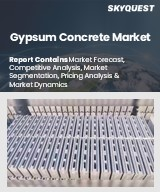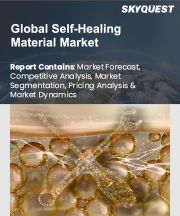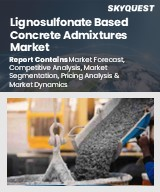
|
시장보고서
상품코드
1831590
석고 콘크리트 시장 규모, 점유율, 성장 분석 : 유형별, 용도별, 건축 유형별, 최종사용자별, 지역별 - 산업 예측(2025-2032년)Gypsum Concrete Market Size, Share, and Growth Analysis, By Type (Poured, Precast), By Application (Floor Underlayment, Architectural Elements), By Building Type, By End User, By Region - Industry Forecast 2025-2032 |
||||||
세계 석고 콘크리트 시장 규모는 2023년에 29억 달러로 평가되었으며, 예측 기간(2025-2032년) 동안 CAGR 5.0%로, 2024년 30억 4,000만 달러에서 2032년에는 45억 달러로 성장할 전망입니다.
세계 석고 콘크리트 시장은 대규모 건축 수요로 인해 크게 성장하고 있습니다. 이러한 확장에 박차를 가하고 있는 주요 요인으로는 가볍고 난연성 복합재료의 채택과 친환경 건축 관행 등이 있습니다. 현재는 제한적인 범위에 머물러 있지만, 오프사이트 건설 및 3D 프린팅과 같은 신흥 분야에서의 석고 콘크리트의 응용 확대는 시장 진입 기업에게 큰 기회를 가져다주고 있습니다. 이러한 추세는 친환경 석고 콘크리트 및 기타 친환경 대안의 개발에서 알 수 있듯이 지속가능한 건설 방식으로의 전환을 반영하고 있습니다. 재생 석고, 시멘트, 3D 프린팅용 포졸란 첨가제의 조합 등 재료 구성의 혁신은 석고 기반 재료의 구조적 특성과 성능을 향상시켜 보다 효율적이고 지속가능한 건설 방법을 촉진하고 있습니다.
자주 묻는 질문
목차
소개
- 조사 목적
- 조사 범위
- 정의
조사 방법
- 정보 조달
- 2차와 1차 데이터 방법
- 시장 규모 예측
- 시장 가정과 제한
주요 요약
- 세계 시장 전망
- 공급과 수요 동향 분석
- 부문별 기회 분석
시장 역학과 전망
- 시장 개요
- 시장 규모
- 시장 역학
- 성장 촉진요인과 기회
- 성장 억제요인과 과제
- Porters 분석
주요 시장 인사이트
- 핵심성공요인
- 경쟁 정도
- 주요 투자 기회
- 시장 생태계
- 시장 매력 지수(2024년)
- PESTEL 분석
- 거시경제 지표
- 밸류체인 분석
- 가격 분석
석고 콘크리트 시장 규모 : 유형별 & CAGR(2025-2032년)
- 시장 개요
- 현장 타설
- 프리캐스트
석고 콘크리트 시장 규모 : 용도별 & CAGR(2025-2032년)
- 시장 개요
- 바닥 밑받침재
- 건축 요소
- 수리와 유지보수
석고 콘크리트 시장 규모 : 건물 종류별 & CAGR(2025-2032년)
- 시장 개요
- 주거용
- 상업용
- 산업
- 인프라
석고 콘크리트 시장 규모 : 최종사용자별 & CAGR(2025-2032년)
- 시장 개요
- 계약업체
- DIY 애호가
- 건축가와 디자이너
석고 콘크리트 시장 규모 & CAGR(2025-2032년)
- 북미
- 미국
- 캐나다
- 유럽
- 독일
- 스페인
- 프랑스
- 영국
- 이탈리아
- 기타 유럽
- 아시아태평양
- 중국
- 인도
- 일본
- 한국
- 기타 아시아태평양
- 라틴아메리카
- 브라질
- 기타 라틴아메리카
- 중동 및 아프리카
- GCC 국가
- 남아프리카공화국
- 기타 중동 및 아프리카
경쟁 정보
- 상위 5개사의 비교
- 주요 기업의 시장 포지셔닝(2024년)
- 주요 시장 기업이 채용한 전략
- 최근의 시장 동향
- 기업의 시장 점유율 분석(2024년)
- 주요 기업 개요
- 기업 상세
- 제품 포트폴리오 분석
- 기업 부문별 점유율 분석
- 매출 전년비 비교(2022-2024년)
주요 기업 개요
- Saint-Gobain(France)
- Knauf Gips KG(Germany)
- USG Corporation(USA)
- National Gypsum Company(USA)
- Georgia-Pacific LLC(USA)
- Etex Group(Belgium)
- LafargeHolcim(Switzerland)
- Yoshino Gypsum Co., Ltd.(Japan)
- Beijing New Building Materials(BNBM) Public Ltd Co.(China)
- Maxxon Corporation(USA)
- PABCO Gypsum(USA)
- American Gypsum Company LLC(USA)
- Boral(Australia)
- Gyptec Iberica(Portugal)
- Formulated Materials LLC(USA)
- CertainTeed(USA)
- Sika Group(Switzerland)
- CRH plc(Ireland)
- JK Cement Ltd.(India)
- India Gypsum Private Limited(India)
결론과 제안
KSM 25.10.15Global Gypsum Concrete Market size was valued at USD 2.9 billion in 2023 and is poised to grow from USD 3.04 billion in 2024 to USD 4.5 billion by 2032, growing at a CAGR of 5.0% during the forecast period (2025-2032).
The global gypsum concrete market is experiencing significant growth driven by the demand for large-scale constructions. Key factors fueling this expansion include the adoption of lightweight, fire-retardant composites and eco-friendly building practices. Although currently limited in scope, the increased application of gypsum concrete in emerging sectors such as offsite construction and 3D printing presents substantial opportunities for market participants. These trends reflect a shift toward sustainable construction methodologies, evidenced by the development of green gypsum concrete and other environmentally friendly alternatives. Innovations in material composition, including the combination of recycled gypsum, cement, and pozzolanic additives for 3D printing, are enhancing the structural properties and performance of gypsum-based materials, facilitating more efficient and sustainable construction practices.
Top-down and bottom-up approaches were used to estimate and validate the size of the Global Gypsum Concrete market and to estimate the size of various other dependent submarkets. The research methodology used to estimate the market size includes the following details: The key players in the market were identified through secondary research, and their market shares in the respective regions were determined through primary and secondary research. This entire procedure includes the study of the annual and financial reports of the top market players and extensive interviews for key insights from industry leaders such as CEOs, VPs, directors, and marketing executives. All percentage shares split, and breakdowns were determined using secondary sources and verified through Primary sources. All possible parameters that affect the markets covered in this research study have been accounted for, viewed in extensive detail, verified through primary research, and analyzed to get the final quantitative and qualitative data.
Global Gypsum Concrete Market Segments Analysis
Global Gypsum Concrete Market is segmented by Type, Application, Building Type, End User and region. Based on Type, the market is segmented into Poured and Precast. Based on Application, the market is segmented into Floor Underlayment, Architectural Elements and Repair & Maintenance. Based on Building Type, the market is segmented into Residential, Commercial, Industrial and Infrastructure. Based on End User, the market is segmented into Contractors, DIYers and Architects & Designers. Based on region, the market is segmented into North America, Europe, Asia Pacific, Latin America and Middle East & Africa.
Driver of the Global Gypsum Concrete Market
The global Gypsum Concrete market is experiencing significant growth due to the increasing demand for eco-friendly and sustainable building materials. This shift towards low-carbon construction practices is driven by regulations encouraging the use of greener alternatives. Gypsum concrete stands out as a viable option because of its recyclable nature, low emissions, and green certification, making it an attractive choice for various applications. As more industries, including commercial, residential, and healthcare sectors, embrace environmentally conscious construction methods, the adoption of gypsum concrete is expected to rise, reflecting a broader commitment to sustainability in building practices.
Restraints in the Global Gypsum Concrete Market
While gypsum concrete offers notable benefits, its higher costs compared to conventional methods can be a significant barrier to adoption. The need for specialized skills among contractors often leads to increased labor expenses, which can deter investment in this technology. In developing regions, many builders opt for traditional flooring solutions to manage costs, allowing for budget allocations towards other essential construction needs. Price sensitivity among smaller developers also limits the market's expansion for gypsum concrete. Despite its long-term durability and compliance with regulations, many developers in more mature economies are willing to embrace gypsum concrete, recognizing its value despite higher initial expenditures.
Market Trends of the Global Gypsum Concrete Market
The Global Gypsum Concrete market is witnessing a significant shift towards innovative applications, particularly in the realms of 3D printing and modular construction. As builders increasingly adopt precast gypsum for its sustainability and resource efficiency, the material's versatility is paving the way for enhanced construction techniques. The emergence of advanced composite materials, such as fiberglass-reinforced gypsum cement-pozzolan blends, is further elevating the performance characteristics of gypsum concrete, enabling the creation of high-strength, low-cost housing solutions. This trend signifies a broader movement towards integrating modern technology with traditional building practices, reflecting a growing demand for efficient and high-performing structures across various sectors, including healthcare and residential projects.
Table of Contents
Introduction
- Objectives of the Study
- Scope of the Report
- Definitions
Research Methodology
- Information Procurement
- Secondary & Primary Data Methods
- Market Size Estimation
- Market Assumptions & Limitations
Executive Summary
- Global Market Outlook
- Supply & Demand Trend Analysis
- Segmental Opportunity Analysis
Market Dynamics & Outlook
- Market Overview
- Market Size
- Market Dynamics
- Drivers & Opportunities
- Restraints & Challenges
- Porters Analysis
- Competitive rivalry
- Threat of substitute
- Bargaining power of buyers
- Threat of new entrants
- Bargaining power of suppliers
Key Market Insights
- Key Success Factors
- Degree of Competition
- Top Investment Pockets
- Market Ecosystem
- Market Attractiveness Index, 2024
- PESTEL Analysis
- Macro-Economic Indicators
- Value Chain Analysis
- Pricing Analysis
Global Gypsum Concrete Market Size by Type & CAGR (2025-2032)
- Market Overview
- Poured
- Precast
Global Gypsum Concrete Market Size by Application & CAGR (2025-2032)
- Market Overview
- Floor Underlayment
- Architectural Elements
- Repair & Maintenance
Global Gypsum Concrete Market Size by Building Type & CAGR (2025-2032)
- Market Overview
- Residential
- Commercial
- Industrial
- Infrastructure
Global Gypsum Concrete Market Size by End User & CAGR (2025-2032)
- Market Overview
- Contractors
- DIYers
- Architects & Designers
Global Gypsum Concrete Market Size & CAGR (2025-2032)
- North America (Type, Application, Building Type, End User)
- US
- Canada
- Europe (Type, Application, Building Type, End User)
- Germany
- Spain
- France
- UK
- Italy
- Rest of Europe
- Asia Pacific (Type, Application, Building Type, End User)
- China
- India
- Japan
- South Korea
- Rest of Asia-Pacific
- Latin America (Type, Application, Building Type, End User)
- Brazil
- Rest of Latin America
- Middle East & Africa (Type, Application, Building Type, End User)
- GCC Countries
- South Africa
- Rest of Middle East & Africa
Competitive Intelligence
- Top 5 Player Comparison
- Market Positioning of Key Players, 2024
- Strategies Adopted by Key Market Players
- Recent Developments in the Market
- Company Market Share Analysis, 2024
- Company Profiles of All Key Players
- Company Details
- Product Portfolio Analysis
- Company's Segmental Share Analysis
- Revenue Y-O-Y Comparison (2022-2024)
Key Company Profiles
- Saint-Gobain (France)
- Company Overview
- Business Segment Overview
- Financial Updates
- Key Developments
- Knauf Gips KG (Germany)
- Company Overview
- Business Segment Overview
- Financial Updates
- Key Developments
- USG Corporation (USA)
- Company Overview
- Business Segment Overview
- Financial Updates
- Key Developments
- National Gypsum Company (USA)
- Company Overview
- Business Segment Overview
- Financial Updates
- Key Developments
- Georgia-Pacific LLC (USA)
- Company Overview
- Business Segment Overview
- Financial Updates
- Key Developments
- Etex Group (Belgium)
- Company Overview
- Business Segment Overview
- Financial Updates
- Key Developments
- LafargeHolcim (Switzerland)
- Company Overview
- Business Segment Overview
- Financial Updates
- Key Developments
- Yoshino Gypsum Co., Ltd. (Japan)
- Company Overview
- Business Segment Overview
- Financial Updates
- Key Developments
- Beijing New Building Materials (BNBM) Public Ltd Co. (China)
- Company Overview
- Business Segment Overview
- Financial Updates
- Key Developments
- Maxxon Corporation (USA)
- Company Overview
- Business Segment Overview
- Financial Updates
- Key Developments
- PABCO Gypsum (USA)
- Company Overview
- Business Segment Overview
- Financial Updates
- Key Developments
- American Gypsum Company LLC (USA)
- Company Overview
- Business Segment Overview
- Financial Updates
- Key Developments
- Boral (Australia)
- Company Overview
- Business Segment Overview
- Financial Updates
- Key Developments
- Gyptec Iberica (Portugal)
- Company Overview
- Business Segment Overview
- Financial Updates
- Key Developments
- Formulated Materials LLC (USA)
- Company Overview
- Business Segment Overview
- Financial Updates
- Key Developments
- CertainTeed (USA)
- Company Overview
- Business Segment Overview
- Financial Updates
- Key Developments
- Sika Group (Switzerland)
- Company Overview
- Business Segment Overview
- Financial Updates
- Key Developments
- CRH plc (Ireland)
- Company Overview
- Business Segment Overview
- Financial Updates
- Key Developments
- JK Cement Ltd. (India)
- Company Overview
- Business Segment Overview
- Financial Updates
- Key Developments
- India Gypsum Private Limited (India)
- Company Overview
- Business Segment Overview
- Financial Updates
- Key Developments



















